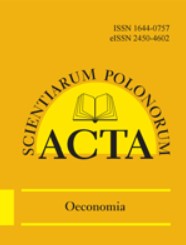OPPORTUNITIES FOR SELF-FINANCING THE USE OF HIGH-YIELDING SUNFLOWER SEEDS AMONGST SMALLHOLDER FARMERS IN TANZANIA: PERCEPTIONS VS. REALITY OF LIQUIDITY LIMITATIONS
OPPORTUNITIES FOR SELF-FINANCING THE USE OF HIGH-YIELDING SUNFLOWER SEEDS AMONGST SMALLHOLDER FARMERS IN TANZANIA: PERCEPTIONS VS. REALITY OF LIQUIDITY LIMITATIONS
Author(s): Felister Yakobo Tibamanya, Joseph A. Kuzilwa, Daniel MpetaSubject(s): Micro-Economics, Agriculture, Evaluation research, Accounting - Business Administration
Published by: Szkoła Główna Gospodarstwa Wiejskiego w Warszawie
Keywords: liquidity limitation; self-financing; high-yielding sunflower seeds; productivity; smallholder farmers; Tanzania;
Summary/Abstract: This paper investigates the opportunities for smallholder farmers to self-finance the use of high-yielding sunflower seeds, by considering their marketable noncommercial asset levels and their perceptions versus the reality of liquidity limitations. The study used a cross-sectional survey covering 416 randomly selected smallholder sunflower farmers in the study area of Tanzania. It makes use of the crafted choice experiment approach to assess the degree of liquidity constraints among smallholder farmers in buying high-yielding seeds, and their willingness to receive a low-interest credit or loan to purchase high-yielding seeds given before or after sowing. Results reveal that liquidity limitation is a perceived rather than a real problem, and it is feasible for farmers to self-finance the use of high-yielding seeds using their own marketable noncommercial liquid assets like livestock and chickens. The results further indicate however, that smallholder sunflower farmers are lacking adequate knowledge of the value of their liquid assets and of the opportunity cost or benefit of taking a credit/loan to finance the use of high-yielding seeds. The implications of these findings is that educating and sensitizing farmers about their potential resources, financial base, and the real cost of credit may influence their choice for self-financing and borrowing options as a way to improve their productivity.
Journal: Acta Scientiarum Polonorum. Oeconomia
- Issue Year: 20/2021
- Issue No: 1
- Page Range: 93-104
- Page Count: 12
- Language: English

